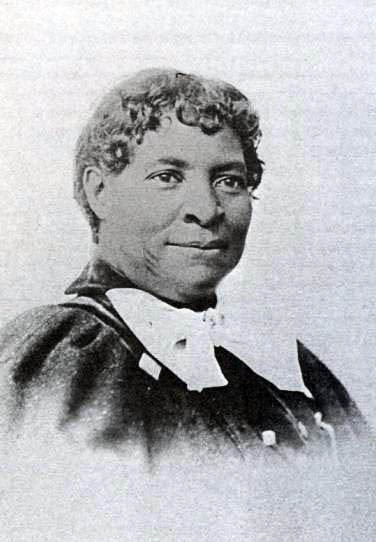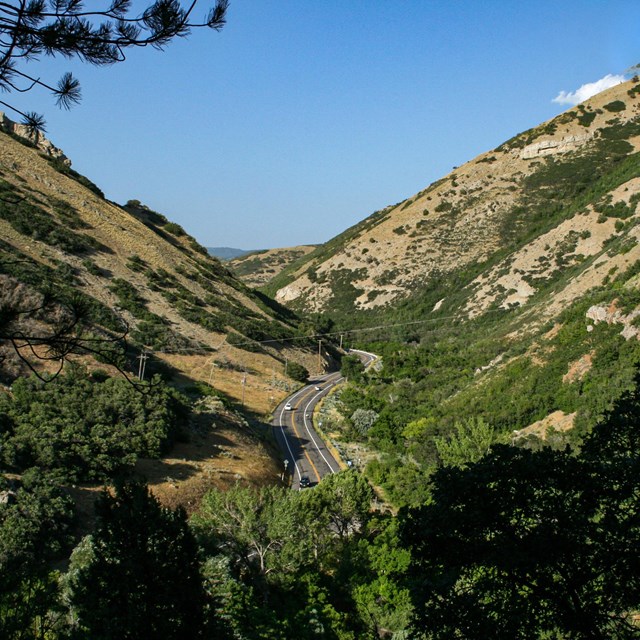Part of a series of articles titled People of the Mormon Pioneer Trail.
Article
Elizabeth “Lizzy” Flake, the Mormon Pioneer Trail

Photo Courtesy of the San Bernardino Historical and Pioneer Society
Elizabeth “Lizzy” Flake – Mormon Pioneer Trail[1]
By Angela Reiniche
Elizabeth “Lizzy” Flake was born enslaved in Anson County, North Carolina, in 1833. As her ancestors had before her, Flake grew up alongside other enslaved people who picked cotton on William Love’s plantation. At the age of five, Love gifted Lizzy to his newly wed daughter, Agnes, and her husband, James Madison Flake. In keeping with common practice, Lizzy took their last name at that time. Not long after, the Flakes joined The Church of Jesus Christ of Latter-day Saints and, along with their slaves—including both Lizzy and Green Flake—they moved to Mississippi where they joined an established congregation of about two hundred former plantation owners and their households. The Mississippi Saints, as this assemblage became known, moved to Nauvoo, Illinois, in 1844 and joined the migration to Utah two years later. Lizzy Flake’s journey, however, would not end in the Salt Lake Valley.[2]
When most of the Saints fled Nauvoo in April 1846, the Flakes made their way to Winter Quarters, Nebraska, where nearly ten thousand of their fellow Latter-day Saints gathered along the Missouri River. On 1 July 1848, Lizzy (now fifteen years old) accompanied the Flake family and more than five hundred other individuals as part of the Willard Richards Company—of which James Flake served as captain—on the 1,100-mile trek along the Mormon Pioneer Trail to the Salt Lake Valley.[3] Throughout the journey, Lizzy continued to look after the Flake children, perform domestic chores, and herd cattle.[4] Along with their slaves, this party of Saints arrived in the Salt Lake Valley in mid-October 1848 and soon afterward settled in Holladay, a small town located a few miles southeast of Salt Lake City.
Two years after arriving in Utah, Lizzy set out on another migration. Along with several other Mormon colonists, she headed to California’s San Bernardino Valley, just east of Los Angeles. In 1850, just before the move, Brigham Young had sent James Flake on a gold-mining mission during which he was killed after being thrown off a mule. Agnes Flake, therefore, led the family to California in a group that contained seventeen-year-old Lizzy, but not Agnes’s male slave, Green. On that trip, Lizzy drove a covered wagon led by two yoke of oxen across the harsh terrain between her home in the Salt Lake Valley and the San Bernardino Valley. More than four hundred Mormon pioneers joined them on the 650-mile trek, twenty-six of whom were enslaved African Americans.[5]
When the pioneers arrived at their destination, Lizzy helped the two youngest sons, William and Charles, build an adobe home for the family. Three years later, however, her mistress Agnes Flake’s fortune and health dwindled. Her worsening tuberculosis drove her to her bed, and Lizzy took charge of the household. Destitute and near death, Agnes asked Amasa Lyman, the church elder who had established the Saints in Holladay, to write Brigham Young and ask him to sell her male slave, Green, to raise funds for her family. That sale, however, never happened.[6]
After Agnes’s death in 1854, Lizzy continued to care for the Flake children. By 1855, William, then sixteen years old, made plans to move the Flake family back to Utah. Though she was a free woman under California law, Lizzy intended to return to Utah with the Flake brothers. She offered to serve William and his future wife, but he encouraged her to stay in California and start her own family. When the family set out for their return trip to the Salt Lake Valley, Lizzy stayed in California and moved in with another Black woman who, like Lizzy, had come across the plains as the property of Mormon pioneers. Even though Lizzy was already legally free, William sent her the paperwork granting her freedom to stay in San Bernardino once he returned to Utah. After 1857, when Brigham Young called the rest of the San Bernardino colony back to Utah, Lizzy found herself without many other Mormon neighbors.[7]
Without a family to care for her, Lizzy supported herself by doing laundry, and the US Census in 1860 reflects that fact. The census records also confirm that she continued to live in San Bernardino and lived with a one-year-old male child named James W. Flake. The census taker recorded Elizabeth’s race as “colored” while the child’s is listed as “mulatto.”[8] That same year, Lizzy met and married Charles H. Rowan, who was born in Washington, D.C. about 1843.[9] The parentage of little James W., who also appears as Walter James in later census records, is somewhat of a mystery given that his last name is recorded as “Flake” in the 1860 census. Charles Rowan, like Lizzy, had also crossed the plains as a slave and worked as a teamster with a Utah company before moving to the San Bernardino Valley. By the time they met, Charles had added the profession of barber to his work as a teamster. Together they bought a piece of land at 361 D Street near downtown San Bernardino and built a home where Lizzy kept house and took in laundry.
By 1880, Lizzy had given birth to another son, Charles, and her husband operated a successful barbershop at the Southern Hotel, less than one block from their family residence. Lizzy and Charles insisted that all of their children receive an education. Walter James, by then twenty-years old, worked as a laborer but remained in the family household.[10] Alice Rowan, their youngest daughter, later became a schoolteacher. She taught white American children, which if not a “first” in California was certainly unusual. Their son, Byron, operated a successful garage north of town, a feed store on “I” street, and eventually followed in his father’s footsteps by working as a teaming contractor on the desert. Lizzy and Charles, a rather successful pair, became pillars of the Black community in San Bernardino and were at the forefront of the early civil rights movement in California. [11] Charles Rowan died in San Bernardino in 1906, while Lizzy died there two years later, on 29 March 1908.[12]
[1] Part of a 2016–2018 collaborative project of the National Trails- National Park Service and the University of New Mexico’s Department of History, “Student Experience in National Trails Historic Research: Vignettes Project” [Colorado Plateau Cooperative Ecosystem Studies Unit (CPCESU), Task Agreement P16AC00957]. This project was formulated to provide trail partners and the general public with useful biographies of less-studied trail figures—particularly African Americans, Hispanics, American Indians, women, and children.
[2] Shirley Ann Moore, Sweet Freedom’s Plains: African Americans on the Overland Trails, 1841–1869 (Norman: University of Oklahoma Press, 2016), 112.
[3] The Flake family lost one son at Nauvoo and buried an infant daughter at Winter Quarters. See Will Bagley, “Black Youths Helped Blaze Mormon Trail,” The Salt Lake Tribune 27 August 2000, p. B1; and for a discussion of Lizzy Flake’s experience driving a team of oxen, see Moore, Sweet Freedom’s, 113.
[4] “First 50, reports, circa 1848 June” in Camp of Israel schedules and reports 1845–1849, Willard Richards' emigration division, MS 14290, Reel 3, Box 2, Folder 32, available online at https://history.lds.org/overlandtravel/ sources/24284199776041819620/first-50-reports-circa-1848-june-in-camp-of-israel-schedules-and-reports-1845-1849-willard-richards-1848-emigration-division-ms-14290-reel-3-box-2-folder-32.
[5] In the 1850 census taken for the Utah Territory, Agnes Flake was listed as having two slaves, a male age 23, and a female, age 17, who was Elizabeth. They are listed among twenty-six slaves “going to California.” Besides Agnes Flake, four other Mormon families took slaves to California, see 1850 Census, Place: Utah, Utah Territory; Roll: M432_919; Page: 147A; Image: 302. 1850 United States Federal Census [database on-line] (Provo, Utah: Ancestry.com Operations, Inc., 2009).
[6] Jonathan A. Stapley and Amy Thiriot, “‘In My Fathers’ House Are Many Mansions’: Green Flake’s Legacy of Faith,” Church History, The Church of Jesus Christ of Latter-Day Saints, accessed 19 February 2014, https://history.lds.org/article/green-flake-pioneer?lang=eng)
[7] It is important to note that not all San Bernardino colonists “obeyed” Young’s orders to return to Utah. One example is found in the story of Hark Lay—the family who owned him moved to Santa Clara where they knew other Mormon settlers had moved.
[8] 1860 Census, Place: San Bernardino, San Bernardino, California; Roll: M653_64; Page: 623; Family History Library Film: 803064. 1860 United States Federal Census [database on-line] (Provo, Utah: Ancestry.com Operations, Inc., 2009). See also Nicholas R. Cataldo, “Lizzy Flake Rowan,” San Bernardino: Where History and the Future Meet (City of San Bernardino, 1998), http://www.ci.san-bernardino.ca.us/ about/history/ lizzy_flake_ rowan_slave.asp.
[9] The year of the marriage is an estimate based on information they provided to census takers when asked how long they had been married. By the time of the 1870 U.S. Census, Elizabeth and Charles Rowan are living in Los Angeles, where he was a barber and she “keeps house.” There are three children living with them – Walter J. (age 11), Byron (9), and Alice (2). All of them are listed as “black.” 1870 Census, Place: Los Angeles, Los Angeles, California; Roll: M593_73; Page: 538B; Family History Library Film: 545572; 1870 U.S. census [database on-line] (Provo, Utah: Ancestry.com Operations, Inc.).
[10] Walter James married E.J. Richards in San Bernardino in 1882, but died four years later at the age of 27. California, County Birth, Marriage, and Death Records, 1830–1890. California Department of Public Health, courtesy of http://www.vitalsearch-worldwide.com.
[11] Cataldo, “Lizzy Flake Rowan,” http://www.ci.san-bernardino.ca.us/about/history/lizzy_flake_rowan_slave.asp; and Moore, Sweet Freedom’s Plains, 113.
[12] Ancestry.com. California, Death Index, 1905–1939 [database on-line] (Provo, Utah: Ancestry.com Operations, Inc., 2013).
Tags
- mormon pioneer national historic trail
- mormon pioneer trail
- national trails
- historic trails
- california
- utah
- black history month
- unm essays
- african american heritage
- african american history
- african american women
- women's history
- women and migration
- migration and immigration
- religion
- religious history
Last updated: February 13, 2023


